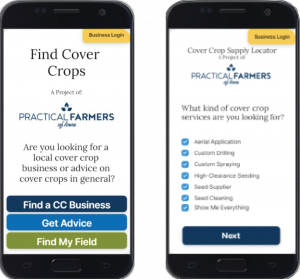New app helps farmers make cover crop decisions
August 11th, 2021 by Ric Hanson
(Radio Iowa) – The non-profit group Practical Farmers of Iowa is launching a new smartphone application designed to make it easy for farmers to make decisions about cover crops in time for fall planting. Sarah Carlson, P-F-I’s strategic initiatives director, says the free app, called Find Cover Crops, aims to be a helpful resource and a time-saver. “Farmers can search with geolocation cover crop business services that are nearby their farm,” Carlson says. “So if you need somebody to custom drill, if you need to find an aerial applicator, or if you need to find seed or any other cover crop services, you can find those locations, find those businesses, reach out to them and hire their services.”
The app also offers embedded how-to videos for seeding, grazing and terminating cover crops, in addition to showing farmers how to precisely identify the boundaries of fields to be cover cropped. The app is free to download via the Apple App Store and the Google Play Store. Perhaps one in ten Iowa farmers have planted cover crops in the past decade, and Carlson says many more need to — but don’t — due to time management issues and logistics. “The number-one reason why we need to use them in the state is to improve our water quality so that we can avoid potential future regulation and hold that nitrogen on our fields,” Carlson says. “And then we see other farmers finding a lot of weed control benefits from cover crops, some are even able to cut herbicides which then basically pays for the cover crop.” 
All sorts of things can be planted as cover crops, but Carlson says cereal rye is the most popular and versatile, as it can be planted into late December. “And then normally putting cereal rye ahead of that next year’s soybean crop, that’s the most common use of cover crops today,” Carlson says. “Honestly, it’s the least risk, it’s the best benefit because soybeans benefit yieldwise after that rye cover crop, and we get improved weed control, reduced erosion, better water quality.”
Privately-funded cost share programs for cover crops are available through the Practical Farmers’ website which Carlson says may bring between ten and 40 dollar per acre, making the practice essentially risk-free. Learn more at: practicalfarmers.org.





